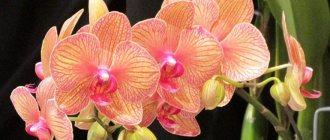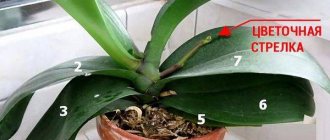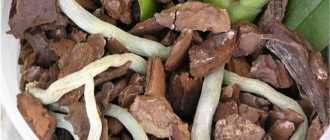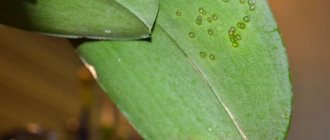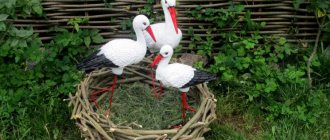Europeans became acquainted with magnificent orchids more than three hundred years ago. The first specimens of these tropical plants, which arrived from the American continent to Holland, amazed even experienced flower growers with their exquisite appearance and duration of flowering .
But in those distant times, exotic beauties could only grow in royal greenhouses. Nowadays, blooming orchids can be seen not only on the windowsills of ordinary apartments.
They fit harmoniously into the interiors of offices and educational institutions, decorate hospitals and libraries, plant greenery in the halls of enterprises and even personal gardens . The successes of flower growers in the study of orchids and the efforts of breeders allowed tropical guests to firmly establish themselves in the homes and hearts of people of the 19th century.
General information about the Phalaenopsis orchid
Appearing in Europe half a century later (1752) than the first orchids, the Phalaenopsis orchid, a representative of the southeastern regions of Asia, also captivated flower growers with its regal appearance , elegant and long-lasting flowering, and most importantly, its unpretentiousness in home culture.
The Phalaenopsis genus includes a fairly large number of species (according to various sources - from 70 to 77), but they are all characterized by a number of similar features:
- Representatives of the genus are monopodial plants, that is, they develop strictly upward due to the apical growth point. They have one strongly shortened stem and a dense rosette of evergreen voluminous and fleshy leaves of a juicy color .
- A distinctive feature of all species is large flowers, collected in rich racemose inflorescences on high peduncles.
- Flowering duration ranges from 3 weeks to 5 months. In many species, repeated flowering is possible on the same peduncle.
- Roots with a thick layer of velamen in most species participate in the process of photosynthesis due to the chlorophyll they contain. Therefore, transparent flowerpots are desirable for Phalaenopsis.
- Almost all species do not have a rest period; they need constant warm conditions . But for successful flowering, a temperature difference (3-5°C) during the day is required.
On a note! Any Phalaenopsis is an ideal choice for beginning gardeners, as it is unpretentious in care and can adapt to the conditions of a particular room.
History of origin
The first mentions of this culture contain Chinese chronicles compiled 2500 BC, and the first flower was found in the distant 18th century by a traveler from Germany Georg Rimpfius , traveling through the Moluccas.
But the plant appeared in the first botanical reference book only in 1752, when another German naturalist, Carl Linnaeus, came into possession of a herbarium containing several carefully dried specimens of an outlandish flower. He gave it the first name Epidendrum amabilis - “living on a tree.”
Almost seven decades later, Blume, director of the botanical garden of Leiden, discovered several more specimens in the Malay Archipelago, and gave them another name Phalaenopsis - from the Greek words “Phalania” (night butterfly) and “Opsis” (resemblance).
The plant appeared in European botanical gardens at the beginning of the 19th century . The price for each specimen reached sky-high heights, and only monarchs could afford to purchase phalaenopsis for their personal collections.
In the 20th century, scientist-enthusiasts Knudson and More, independently of each other, developed the first hybrid, which easily crossed with other orchids. Anyone could now breed the variety. Hundreds of books have been written where you can read everything about it - the beautiful phalaenopsis, how to grow it yourself at home, how to replant and propagate.
Popular varieties in home culture
Among the numerous varieties of Phalaenopsis, any gardener will be able to select specimens to suit their taste or based on the needs of the collection.
Interesting! The corollas of Phalaenopsis are similar in appearance to butterflies, which gives the name to the whole genus (moth-like). The color palette of flowers includes all rainbow shades, which further increases the resemblance to delicate insects.
For beginners and amateurs, we can recommend the most common varieties in home cultivation, photos of which will help you make a choice.
Phalaenopsis mix
A hybrid specially adapted for indoor culture. Requires minimal care . A large plant (height with peduncle reaches 0.7 m) with large butterfly flowers of all shades of the rainbow.
The leaves are standard for the genus - large, leathery, oval-round in outline . It blooms multiple times in one year with long periods of corolla retention.
Phalaenopsis blue
There are no consistently blue varieties in nature. Several hybrid forms and natural varieties are known with delicate and subtle tones of blue and lilac (sometimes on a white background).
All bright blue specimens sold are tinted with natural dyes using a special technology. The second flowering of such forms is usually white or pale blue , but not all sellers honestly warn about this.
Other characteristics depend on the variety chosen for tinting.
Phalaenopsis Philadelphia
A distinctive feature is large, oval-elongated leaves with a marble pattern, covered with a glossy coating. The inflorescences are of medium height and branch well . It blooms gently with lilac butterflies.
Phalaenopsis Stewart
It is distinguished by narrow, long leaves with light patterns, as well as silvery roots. Multi-flowered inflorescences - sometimes about 60 buds at a time on high peduncles (up to 80 cm) bear small white fragrant corollas.
Blooms during warm periods. Duration – no more than 30 days.
Phalaenopsis Magic Art
Not a very large orchid (about 60 cm) with oval dark green leaves . It is distinguished by brightly colored corollas: crimson droplets are scattered across the white petals, complemented by streaks of the same color.
The middle is red with crimson and yellow tints . Blooms twice a year.
Unusual Phalaenopsis are very popular in culture:
Dendrobium Phalaenopsis
Belongs to the genus Dendrobium, it received its name for the resemblance of the corollas to butterfly orchid flowers.
Dendrobium Phalaenopsis has a sympodial type of growth , that is, it can grow in width due to the formation of new shoots on the rhizome. The leaves are long and narrow. The inflorescences are formed from pseudobulbs, the flowers are white to purple in color.
Phalaenopsis mini
The Phalaenopsis mini orchid differs from other species only in its insignificant peduncle height (no more than 20 cm). It has large thick leaves of green (less often spotted) color .
Blooms both in summer and winter months. Flowers are butterflies of various shades.
What kind of plant is this?
What kind of orchid is this magnificent phalaenopsis?
The name phalaenopsis unites not one, but several varieties of orchids, bred specifically for home cultivation. All of them are unpretentious and feel great in modern homes.
Phalaenopsis belongs to the Orchidaceae family . In nature, these flowers grow either in the form of herbaceous bushes on trees, or in lithophytic herbaceous groups on the surface of the earth.
Habitat: Philippines, northeastern Australia, southeast Asia, Pacific Islands. Orchids prefer a height of 200-400 meters above sea level, rocks in the depths of tropical rainforests, trunks and crowns of trees.
How to choose Phalaenopsis in the store
In order for the orchid to quickly adapt to its new apartment conditions and feel comfortable, when purchasing a plant you should take into account some nuances:
- It is possible to determine the color of a future pet only in a blooming state. In addition, blossoming buds without disturbing the richness of color , firmly sitting on the peduncle, will show a healthy plant. – Buy an orchid during flowering.
- A sick plant will be revealed by its root system: if the roots are sluggish, with spots of rot, and the orchid sways in the pot when touched, then you should not buy it (the flower is weakened). – When purchasing, check the health of the roots.
- A healthy orchid certainly has powerful, fleshy leaves . They should not have cracks, scratches or dry areas. Most varieties have dark greens. – When buying an orchid, pay attention to the leaves.
Hybrid
Crossing phalaenopsis is not one of the most labor-intensive processes in botany, so industrial cultivation is reaching new heights in the cultivation of this genus of orchids. Hybrids are divided into several categories, depending on the size of the flower and the type of flowering.
Miniature (Phal. Mini Mark “Maria Teresa”)
- A striking representative is mini phalaenopsis. They are very convenient to keep at home or in the office; they do not take up much space.
- Fragile graceful flowers are painted in different shades, from light pink to rich tones.
Taiwanese (Amboinensis, Venosa, Violacea)
- Unlike miniature, discreet flowers, orchids of this group are strewn with large flowers of exotic colors.
A distinctive feature is the unusual colors, the sharp contrast between the petals and the lip. - The unpretentiousness of plants was also included by botanists in this section of hybrids.
Novelty Group
This group includes: Prefection In "Chen", l-Hsin Spot Eagle "Montclair", Nobby's Pacific Sunset "Red Pearl", Brother Pirate King "Sapphire Dragon", Misty Pride "CR".
- The uniqueness of the group is that after finishing flowering, the plant goes into a resting phase. Then the peduncle comes to life, and by the new flowering period new buds appear from its top.
- An orchid produces two or more flower stalks at once.
- Another distinctive feature of Novelty hybrids are specks, strokes, veins and other patterns on the petals.
In addition to the above varieties and hybrids, phalaenopsis also deserve the attention of the gardener: Big Lip, Wild Cat, Liodoro and Multiflora.
Caring for an indoor orchid
Orchids of the genus Phalaenopsis have the ability to quite easily adapt to the conditions in which they have to grow. For this reason, they are rightfully considered the most unpretentious and easy to keep exotic beauties.
Even a beginner in the art of floriculture can take care of a butterfly orchid at home
Important! The orchid is a representative of the tropical flora. This means that she has a slightly different approach to environmental factors: she loves a lot of light, moisture and warmth. Proper care after purchasing a Phalaenopsis orchid is aimed at creating for it a life close to its natural habitat.
Placement and lighting
The ideal location for butterfly orchids is on south-facing window sills. With this option, the plant will receive enough sunlight even in the cold months . But in summer, a shading system should be provided from direct rays of the sun to protect the flower from burns.
Location on the windows of the eastern and western sides of the rooms is also acceptable when keeping orchids. In this case, the light will be diffused, and its quantity will be sufficient for normal life activity, including long-term flowering.
If the plant is forced to be located on the northern window of the room, then in order to maintain the proper level of illumination it is necessary to provide additional illumination with daylight spectrum lamps, especially in the winter months. Otherwise, the plant will not have enough strength to form buds (they will be spent on leaf growth), and immunity may decrease. And this threatens health.
For any arrangement, it is recommended to periodically rotate the Phalaenopsis pot to create a harmonious outline.
Temperature
The butterfly orchid is quite thermophilic: the optimal temperature range is +18 +24°C. Under such conditions, the plant will experience sufficient growth of green mass and lush flowering for several weeks (and even months).
A short-term decrease in temperature to +14 +16°C is acceptable, but prolonged cooling is fraught with a slowdown in life cycles.
Keeping a flower for a long time in hot conditions (above + 28°C) can provoke rapid leaf growth with a simultaneous deterioration in the quality and duration of flowering .
Almost all types of Phalaenopsis bloom several times a year; they do not have a pronounced dormant period. Therefore, to ensure stable flowering, the plant requires a daily temperature change of approximately 5°C. In cold weather, such conditions develop naturally on the windowsill. In summer, it is advisable to open the window at night.
Advice! When trying to create a daily temperature difference for an orchid, it is necessary to monitor the movements of air masses. Phalaenopsis reacts negatively to drafts!
Humidity and watering
The well-being of a flower largely depends on the air humidity in the room and proper watering.
The butterfly orchid has a twofold attitude towards humidity. The ideal for her is values ranging from 60 to 80%, but the tropical beauty can easily adapt to significantly lower numbers (that is, to the usual air humidity of city apartments). The main thing is not to allow the threshold to drop below 40%.
If necessary, air humidity can be changed using humidifiers, spraying or trays of pebbles and water.
Important! Increasing humidity can combat elevated temperatures, but it requires more frequent ventilation.
Having decided to purchase Phalaenopsis, you should think about the watering schedule in advance, taking into account different periods of the growing season and how to prevent the soil from overflowing or drying out .
This video explains how to care for phalaenopsis orchids at home.
The orchid should be watered regularly, but sparingly throughout the year.
Each subsequent watering depends on weather conditions and is carried out after the soil has dried out a little : the orchid tolerates minor drought more easily than heavy moisture.
Attention! You can determine the time of watering by the color of the roots: the green color indicates that the roots are full of moisture, the drying of the soil will be marked by the silver-gray tonality of the root system.
All procedures with water (watering, spraying) are carried out in the first half of the day so that the plant does not cool down at night. Watering is allowed only by immersion method.
Soil and fertilizers
Since Phalaenopsis roots are involved in the process of photosynthesis, they require a loose and breathable substrate. It would be ideal to use bark harvested from the forest and boiled to remove pests and resin.
It is allowed to keep the plant without a substrate - the roots must be fixed on a special block or simply in a wooden basket.
Butterfly orchids do not require the use of fertilizers, since they independently obtain all the elements from the environment.
Natural views
Phalaenopsis are the most unpretentious and popular orchids for home breeding. They have monopodial growth, which is a distinctive feature. The stem of this genus of orchids does not branch and grows slowly in length. It can reach 40 cm during the flowering period and produces 1-2 leaves once a year. Flowers gradually bloom from the base to the crown and can maintain a decorative appearance for several months.
You can often find pleasant phalaenopsis (Phalaenopsis amabilis), Schiller's phalaenopsis (Phalaenopsis schilleriana) and Stewart's phalaenopsis (Phalaenopsis stuartiana). Stewart's phalaenopsis (Phalaenopsis stuartiana) and Schiller's phalaenopsis (Phalaenopsis schilleriana) are distinguished by snow-white flowers with scarlet patches and variegated leaves. Of particular interest are the forms of these species with large, colorful flowers.
Phalaenopsis amabilis (Phalaenopsis amabilis)
This orchid is also classified as Phalaenopsis charming. Found in Australia, Indonesia, and the Philippines. One of the key species used in hybrid breeding. A monopodial plant on a short stem is distinguished by lush flowering and unpretentiousness.
Phalaenopsis amabilis is popular in indoor and greenhouse floriculture. On the short stem of an adult plant, 4-5 two-row leaves grow, reaching up to 50 cm in length and 20 cm in width. The surface is glossy and shiny, sometimes with a pattern of yellow longitudinal stripes. The shape of the leaves is elongated-elliptical. A healthy plant has smooth branched roots and a strong rhizome.
Inflorescence with numerous flowers and a strongly branched large curved raceme (40-70 cm). The peduncle produces about 15-20 buds, which open into large white flowers up to 7-10 cm in size. Over time, the petals acquire a cream or light pink hue. Needs frequent watering, optimal temperature is +22…+27°C. Should be shaded from direct sunlight.
Phalaenopsis schilleriana
Phalaenopsis Schiller became the ancestor of many hybrid varieties. It is endemic to the Philippines, where it grows in warm tropical forests. During the flowering period, you should not allow a sharp change in daily temperature - this can cause the buds to fall off.
This species is similar in appearance to Phalaenopsis amabilis, but its main distinguishing feature is its variegated leaves. On the upper part they have spots of silver-gray and dark green, which are combined into stripes located transversely. Reddish spots can be seen below.
The inflorescence is multi-flowered (up to 200) and branched, reaching a length of 1.5 m. The size of each flower is 7 cm. The color is light pink, with lateral sepals with scarlet specks at the base. Flowering time is February-May. This species can be grown both in pots and epiphytically.
Phalaenopsis violacea
Phalaenopsis violation, or purple phalaenopsis, is found in Malaysia and on the island. Sumatra. It is distinguished by purple flowers, sometimes with a light green edging of the petals. But there are variations of white, lilac and pink shades, as well as specimens with speckled flower patterns.
The leaves are glossy, bright green, elliptical in shape, reaching 25 cm in length and up to 12 cm in width. The peduncles are zigzag, with a small number of buds that open one by one. The flower is waxy, up to 4-6 cm, fragrant. Phalaenopsis violet blooms profusely from June to October.
The optimal temperature should be within +18…+25°C. Do not allow direct sunlight to hit the flower. Violation loves high air humidity - 75-80% (at least 60%, otherwise the growth and development of the plant will slow down). When watering, ensure good drainage, otherwise the plant's roots will begin to rot.
In nature, it prefers to live on mangrove trees. In winter, water once every 2 weeks, in summer more often. Every 3rd watering it is worth applying fertilizers (root and foliar methods).
Phalaenopsis bellina
Phalaenopsis bellina is similar to Phalaenopsis violet. Habitat: o. Borneo. There is no clear opinion in the scientific community whether one of the species is one of the natural variations of the other. Bellina is distinguished by wider and oval petals and leaves, and larger flowers.
The stem is short with glossy bright green leaves, the shape is elongated and round, reaching up to 30 cm in length. Revolver-type peduncles produce up to 3 medium-sized flowers with a diameter of 5-7 cm with a strong aroma. The edging of the petals is pale green, the sepals are purple, pink, and lilac.
Tolerates sun well, preferably planted on a wood block. Requires moderately warm conditions (+18...+25°C) and air humidity of 50-70%. Watering no more than once every 10 days; due to the almost constant growing season, it requires regular feeding (once every 7 days).
Phalaenopsis stuartiana
This species was first seen on the island. Mindanao (southern Philippine archipelago). An evergreen orchid that produces up to 100 flowers during the flowering period with a subtle aroma. The flowers can reach up to 10 cm in diameter, but usually do not exceed 5 cm. Flowering periods occur in winter and spring.
The upper petals are wide, creamy-white, and at the base they are covered with a small scattering of colored spots. The lateral sepals are light yellow, the lip is covered with brownish-purple spots. The leaves are variegated, elliptical-oblong in shape. Healthy plants have pronounced turgor of green mass. It is worth watering no more than once a week.
Externally, this orchid resembles Schiller's phalaenopsis. Prefers partial shade, well-humidified air and a temperature of +22...+24°C. During the flowering period, fertilize every 2 weeks, during dormancy once a month. It is recommended to use lukewarm water for watering.
Phalaenopsis lobbii
The miniature orchid is found in India, Burma, and Vietnam, and grows on trees. First discovered by Thomas Lobb in 1845, today it is a protected species. In nature, it lives on the trunks and branches of old, moss-covered trees. Mature plants can produce several peduncles with a revolving type of flowering.
From the base of a short stem grow 2-4 pairs of elliptical leaves, up to 15 cm long and up to 5 cm wide. In winter, the plant sometimes actively sheds its leaves. The peduncles are thin and short (up to 10-15 cm), producing 2-6 buds almost all year round, opening sequentially. Flowers are up to 2 cm in diameter, dense, color from white to cream, the lip is wide, trilobed. There are 2 wide stripes of yellow color, the column is covered with brown specks.
The root system is well developed, with numerous branches. The preferred temperature range is +18...+30°C (taking into account daily differences). Phalaenopsis Lobba tolerates bright sun light and air humidity of about 70%. Standard watering regime (every 7-10 days). During the period of active flowering (February-May), it is worth feeding the orchid with special fertilizers every 2 waterings.
Phalaenopsis sanderiana
One of the rarest, most beautiful and expensive species of phalaenopsis. Named after the famous orchid lover Sander. The famous orchid researcher Lindley said about this plant: “a flower that is as charming as a beautiful young maiden.”
The stem is short, it has 2-6 dark green leaves with a variegated pattern, the leaf shape is oval, slightly pointed at the edges. The roots are smooth and well developed. On long, drooping peduncles, up to 50 flowers with a diameter of 5–8 cm are located in opposite rows. There are a variety of colors.
Large-flowered hybrid, peak flowering occurs in spring-summer. The preferred temperature is +23...+32°C and humid air (up to 80%). Abundant watering is required with a two-week break. Moderate lighting of medium intensity will be required.
Phalaenopsis tetraspis
Phalaenopsis Tetraspis, or four-shielded phalaenopsis, is found in India and Indonesia. During the flowering period (spring-summer) it produces a long peduncle (up to 30 cm). After the first flowers fade, the peduncle grows and new buds appear. Flowers up to 5 cm in diameter, usually white (sometimes with an admixture of red).
Adjacent to the trunk are up to 10 long, dark green leaves that curve toward the bottom. It feels great at 60-70% humidity in the room; if the air becomes drier, the orchid begins to turn yellow. Watering should be done intermittently so that the substrate has time to dry completely. For phalaenopsis tetraspis, watering using a warm shower is suitable.
A moderate temperature regime, range +20...+30°C (taking into account a daily difference of 10°C), is suitable for keeping. The plant loves bright light, but should be protected from direct sunlight. Fertilize once a month, during the active growing season every 2 weeks. Transplantation is recommended no more than once every 2-3 years, in March-April. After transplantation, you should not water the orchid for 7-10 days.
Phalaenopsis lueddemanniana
This species belongs to miniature orchids. The flower received its name in honor of the French breeder F. Luddeman. They grow in tropical Philippine forests with high humidity. They prefer temperatures of +23...+34°C; during the active growing season they should be fertilized once every 2 weeks.
The leaves are light green, oval in shape with pointed ends, grow up to 25 cm in length, up to 12 cm in width. The peduncle is straight or arched, has the same length as the leaves, or a little longer. Produces up to 5-7 buds, opening with flowers up to 5 cm in size.
The flowers are up to 7 cm in diameter, with variegated petals and sepals, as well as a small, three-lobed lip. Peak flowering is spring-early summer, the buds open alternately and emit a delicate aroma. The flowers are pink and purple, the shade is more saturated towards the center.
Doritis beautiful (Phalaenopsis pulcherrima)
The Phalaenopsis species Doritis pulcherrima does not have an established name in the Russian classification. These orchids are widespread and are found in China, India, Malaysia, Thailand, on the island. Borneo and Sumatra, in Cambodia, Vietnam and other countries. Gave rise to many hybrids called Doritaenopsis.
On a short stem there are 4-8 hard gray-green leaves of an elongated elliptical shape, slightly pointed at the ends. Sometimes on the leaves there is a pattern of fuzzy stripes or specks of a green tint. The root system is strong, well developed, the roots are highly branched, smooth, and silver in color.
During the flowering period, it produces a long peduncle (up to 60 cm) with multi-flowered inflorescences. Small flowers reach 1.5-4 cm in diameter, peak flowering occurs in October-December. Color ranges from pale and purple pink to deep lilac. The lip is three-lobed, the lateral lobes are straight, the middle lobe is elliptical, with the edges inward, the column is straight and narrow.
Doritis is a beautiful, unpretentious, heat- and moisture-loving plant to care for. This phalaenopsis prefers a temperature of +22...+24°C, air humidity 50-80%. Water at such a frequency that the substrate always remains slightly moist, but not wet. You should not fertilize during the dormant period (January-February); the rest of the time, fertilize every 10 days.
Phalaenopsis equestris
The miniature species Phalaenopsis equestris is found in the Philippines, Taiwan and on. Borneo. The leaves of the plant are oblong-oval, reaching 8 cm in length. It produces small dark purple flower stalks (about 20-30 cm).
The peduncle is racemose, produces up to 15 medium-sized flowers of white-pink or variegated colors, up to 3 cm in diameter. The buds bloom one after another, the peduncle should not be cut off - it can continue to grow. The lateral lobes of the flower are bright pink, slightly protruding forward. The anther is bright pink, diamond-shaped.
For long and abundant flowering, you should maintain an increased temperature regime (up to +34°C) and additionally humidify the air. Watering is regular and moderate; roots should not be allowed to rot due to excess moisture. Grows best on wood blocks.
Giant Phalaenopsis (Phalaenopsis gigantean)
The Phalaenopsis Gigantea orchid comes from the forests of South and Southeast Asia, Northeast Australia, and the Philippines. It is the largest representative of Phalaenopsis; it was first found in 1897 on the island. Borneo. Easily crosses with other species and hybrids of its genus. It grows slowly, the first flowering can be waited for 5-12 years. This is a spectacular, but difficult to care for flower, sensitive to climatic conditions and growing techniques.
The peduncle is drooping or arched, 30–40 cm long, bearing a spike-shaped multi-flowered inflorescence of up to 30 buds. The flowers are up to 7 cm in diameter, round in shape, and have a pleasant aroma with notes of citrus. The color ranges from light yellow to greenish and cream, with red-brown speckles. Peak flowering occurs in the summer months.
The leaves are leathery, green, up to 1 m long, up to 40 cm wide. Prefers a temperature of +23...+30°C, a short-term decrease to +15°C is allowed. Requires bright lighting, loves plenty of sunlight. Water once a week, avoiding drops of water getting into the rosettes of leaves. The root system is poorly developed and does not tolerate transplantation well. When changing the soil, you should protect the roots.
Phalaenopsis lowii
Origin: Myanmar, Thailand and. Borneo. A medium-sized orchid, it is considered finicky to grow. In its natural environment it lives on limestone rocks or tree trunks.
An inflorescence of 5–12 flowers is formed from July to October. Flowers range from white-pink to amethyst, up to 5 cm in diameter. The lip is 3-lobed, equal in length to the length of the petals. The lateral lobes are sickle-shaped (sickle-shaped), ending in a hook, the column is beak-shaped.
The roots are few, smooth, the trunk is short. The leaves are oblong-ovate, up to 9 cm long and up to 3 cm wide. When exposed to excess light, they acquire a red tint. The soil should not be allowed to dry out, otherwise the plant will shed its leaves and die. It is recommended to shade the lighting and protect from direct sunlight. Abundant watering is required no more than once a week, the optimal temperature is +16...+28°C.
Orchid transplant
Orchids do not like interference in their life processes, so transplants should be done as rarely as possible: in case of damage to the bark (flooding or caking) , to increase the volume of the pot, or due to the appearance of pests. Ideally, one transplant every 3 years.
Transfer rules
The transplant procedure should be thought out in advance step by step:
- Remove the orchid from the pot by cutting the container;
- Rinse the root system;
- Remove damaged and diseased roots, yellow and old leaves, treating all cuts with charcoal;
- Dry the roots, place in a new pot and sprinkle with bark;
- After transplantation, do not water for about a week, keep in a warm and bright place;
- Next, treat the bark every morning with a solution of succinic acid to increase immunity and accelerate growth.
This video shows how to re-salt an orchid after purchase.
Potty requirements
Phalaenopsis, due to the characteristics of the root system - the presence of chlorophyll and participation in photosynthesis - love transparent plastic pots , but you can also use blocks or baskets (when growing a flower without soil). Read more about orchid pots.
Orchid blossom
The most important moment in the life cycle of an orchid, which all Phalaenopsis owners look forward to, is the flowering period.
In Phalaenopsis it occurs at different times , with different frequency and duration (depending on the species). But it's always a great spectacle.
Conditions required for Phalaenopsis to bloom
To form flower buds, an orchid requires very little - only careful adherence to all rules and maintenance regimes :
- It is necessary to maintain constant lighting levels throughout the year whenever possible;
- Use lighting in winter;
- Try to create a daily temperature difference.
Even in the absence of any point, the Phalaenopsis orchid will try to bloom at least once a year , because it is not without reason that it is the most unpretentious beauty.
Why doesn't it bloom?
Mistakes made when caring for Phalaenopsis contain the answer to the question: the orchid does not bloom, what should I do? Possible reasons include:
- Lack of lighting;
- Root rotting due to overwatering;
- Lack of daily changes or extreme heat ;
- Stress after transplant;
- Bacterial diseases;
- Excessive fertilizing with nitrogen.
If the last flowering took place more than a year ago , and the plant is not trying to form a peduncle, then all care regimens should be adjusted.
Phalaenopsis has faded, what to do next?
The following tips will help you decide how to care for a faded orchid:
- Do not remove the green peduncle - possible re-blooming or the formation of a baby Phalaenopsis orchid on a peduncle;
- Trim only completely dried arrows at the root;
- Cut the peduncle back to the first living meristem (dormant bud) in hopes of repeat flowering.
But if the plant is weakened, then after the flowers fade, it is advisable to immediately cut off the arrow to give the orchid time to recover.
What is the difference from other types?
- Phalaenopsis does not have false bulbs (tuberidia).
- The substrate serves as a support, so you can use light soil.
- Blooms several times a year.
- Monopodial growth.
- The air needs more moisture.
- The flowers are always larger.
- The leaves are semicircular.
We talked in more detail about the difference between phalaenopsis and other orchids in this article.
Reproduction of phalaenopsis
To obtain new orchids of the Phalaenopsis genus, flower growers have two options: sexual reproduction (by seeds) and vegetative reproduction (by children). The seed method is too complicated and not always successful. It is used by experienced breeders to develop new varieties.
The simplest thing is to get a baby from your orchid. Sometimes vegetative propagation occurs without human intervention. The baby is formed from meristems on the arrow left after flowering or in the axils at the base of the leaves. In some cases, gardeners resort to stimulating the orchid to form layering using growth stimulants.
Occasionally, the children that appear do not want to produce roots . This happens due to mistakes in caring for the mother orchid. Experienced gardeners will tell you how to grow roots in this case:
- Separate the baby with a piece of peduncle, secure it on the foam so that the end of the stem is above the small hole, but does not touch the water in which the impromptu boat will float.
- Place the baby on sphagnum moss in a mini greenhouse .
- Try to get roots without separating the baby from the mother plant, wrapping it in moss and wetting the resulting cocoon.
What to do with phalaenopsis immediately after purchase
When you bring a new phalaenopsis orchid home from the store, immediately provide it with proper care at home.
- First of all, it is necessary to replant the phalaenopsis, since inside the pot the manufacturer often places a kind of “cushion” of compressed moss, foam rubber or peat. This significantly waterlogs the neck from below and causes rotting of the roots inside the pot.
- Also, when caring for a flower at home, you need to immediately decide on the location: phalaenopsis do not like moving. For them, new conditions are already serious stress. Place the transplanted plant in a well-lit, warm place and do not rotate the pot unless absolutely necessary. Try to remember how you placed the flower so that after watering you can place it the same way.
- By providing proper care, you can reduce stress to the plant. The drugs Epin and Zircon also have an anti-stress effect.
- Don't rush with watering. The first time you need to do this using a spill, carefully, along the edge of the pot. Any remaining water from the pots must be drained immediately.
- Feeding should begin after a month.
- If you have several orchids, then the new plant should be kept in quarantine. This is due to the fact that phalaenopsis may be infected with an infection or there may be various parasites in the pot. During the first month it is necessary to observe the plant, and only then add it to the rest of the collection.
Phalaenopsis diseases
Diseases can be caused by errors in care, fungi or bacteria.
Sticky spots on leaves
If the plant suffers from uncomfortable conditions, sticky drops may appear on the leaves of the Phalaenopsis orchid. These glue-like droplets give a signal to revise your care regimen.
But sometimes the drops appear as protection against pests or as a means of attracting pollinators . In these cases, there is no need to worry.
Decreased leaf turgor
If the question arises: how to restore leaf turgor in a Phalaenopsis orchid, you should care for the plant based on the reasons that caused this problem .
Loss of turgor is also caused by improper care: compacted soil, overheating of the underground part, uncontrolled watering. The cause should be found out and care adjusted .
Hives
Phalaenopsis disease is characterized by small spots (up to 3 cm) on leaf blades.
The reason lies in the cold and too humid air of the room without sufficient ventilation. To combat urticaria, it is enough to change the conditions of care.
Fusarium
A disease that is dangerous for an orchid is caused by fungi that have entered the roots and base of the stem through the soil. Causes rotting of the underground parts of the plant, which gradually spreads to the above-ground parts.
Carefully! Fusarium can only be treated before rot appears, so when pinkish-white dust particles are first detected, the orchid is quarantined and treated with fungicides.
When plants rot, they must be destroyed to prevent mass infection.
Botrytis
A fungal disease characterized by brownish and black speckles on buds and flowers. It occurs due to moisture getting on the petals and in the axils of the leaves.
Botrytis disrupts the decorative effect and, without treatment, can lead to the death of the orchid. To cure, the affected parts should be removed and treated with a fungicide .
Please also pay attention to the beneficial effect of succinic acid on orchids both for diseases and for prevention.
Phalaenopsis pests
Of the parasites that affect Phalaenopsis, the most dangerous are thrips , spider mites, scale insects, mealybugs and slugs. Measures to combat them include preventive examinations and treatment with insecticides when infected.
Love your Phalaenopsis orchid, take care of it, and the orchid will respond with magnificent blooms .
This video talks about mistakes in caring for the Phalaenopsis orchid and how to grow a healthy plant.
About hybrids, names and descriptions
Breeders began refining the genus almost immediately as soon as they received several original plants. As a result, the first hybrid was produced in 1875. The famous botanist John Seden crossed the Aphrodite phalaenopsis with the Ecumenical species. At first he did not produce flowers, and the first buds were obtained after painstaking work on improvement, which lasted almost 11 years.
By the beginning of the 20th century, there were already 13 artificially bred varieties. The first truly interesting hybrid was created in 1940. It was named Doris (Phalaenopsis Doris). This species is distinguished by large snow-white flowers, whose diameter is 140 mm.
Maria Teresa is particularly charming . The plant grows only up to 25 cm, but produces many flower stalks with a large number of small cream buds, whose petals are decorated with small crimson-golden specks.
Among the spotted phalaenopsis, it is worth highlighting the hybrid Paradise . This brainchild of French breeders blooms medium-sized flowers with oblong yellowish-green petals covered with pink-chocolate spots.
Having exhausted all the possibilities of intrageneric crossing, scientists began to hybridize phalaenopsis with other orchids of similar origin. The first fruit of their efforts was Doritaenopsis . The variety appeared in 1923 - it was distinguished by the bright scarlet color of its buds. Further work led to the appearance of plants with orange, purple, and burgundy petals.
A very remarkable hybrid Lip , which we call (due to the striking resemblance of the buds to graceful winged insects) “Butterfly”. The native name means “Big Lip” - and it’s true that in representatives of this variety the lower petal is noticeably hypertrophied and widely spread. The buds themselves are very delicate and large - the diameter is 100 mm. Shades range from milky to purple. Some varieties are variegated.
Nowadays, there are thousands of hybrids, many of which bear very little resemblance to the “purebred” representatives of the genus in question. You can find out more about the most interesting of them on the pages of our website.
The diversity of phalaenopsis makes them welcome guests in the homes of flower lovers. These orchids are not capricious, and therefore maintenance usually does not cause any particular difficulties.
